Dunes—Shades of Sand
- Kent Burkhardsmeier

- Feb 3, 2022
- 8 min read
Updated: Sep 14, 2022
travel stories with landscape photographic artist
kent j burkhardsmeier
9 more miles
Table of Content
—> More Arizona
—> Thanksgiving
Shades of Sand Zen
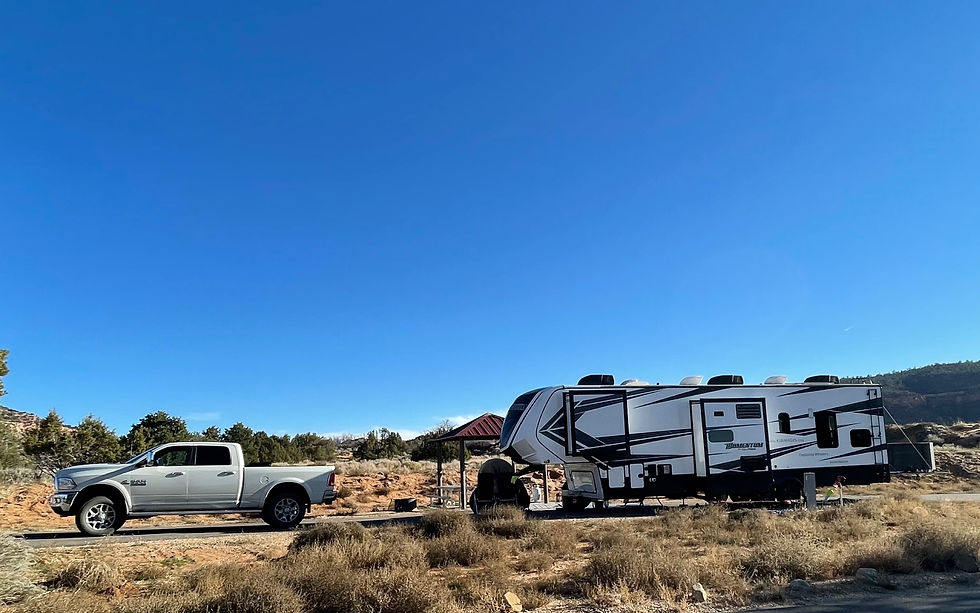
As I crisscross America, I am learning that there are many dune fields in the country. Each one has a different color—what I call: shades of sand. Last month during my travels, I photographed khaki-tan dunes at Mesquite Flats Dunes. This month I photograph salmon-pink and drywall-white shades of sand.
Departing the campsite at Furnace Creek in Death Valley National Park (DVNP), I headed into Nevada to camp near the last remaining desert oasis and stroll during the night in a ghost town. Then I traveled on to the salmon-pink sand dunes within southwestern Utah.

Sedona (AZ), with its magical rock formations and mystical vortices, is one of my favorite southwestern locations. Unfortunately, there are few campsites in the area, and none had openings. Luckily, I found a lovely RV park outside Camp Verde, about 45 minutes south of Sedona.
Heading east out of Camp Verde (AZ), I passed through the beautiful, forested parts of AZ along the Mogollon Rim to Lyman Lake State Park (AZ). From Lyman Lake, I drove across US Highway 60 towards Alburquerque (NM) passing through Pie Town (NM) and past the VLA. While in Alburquerque (NM), Whispers received a new replacement awning! Criss also received something new in Alburquerque (NM).
I celebrated Thanksgiving with family in Santa Fe (NM). After Thanksgiving, I departed Santa Fe and I headed to Alamogordo (NM) for some drywall-white sand.
Being present in a dune field offers a moment of Zen.
Ghost Town, Oasis, and Underground River
(November 1 - 4)
Amargosa Valley (NV)

Not far outside the eastern boundary of Death Valley NP (DVNP) flows the Amargosa River. The river starts in the mountains near Beatty (NV) flowing south under the Amargosa Desert. It turns west and then north before terminating into the aquifer that feeds DVNP's Badwater Basin. The river traverses some 200 miles from start to finish, ending a mere 50 miles away (as-the-crow-flies) from its headwater. Badwater Basin is the lowest point on the North American continent (-282 feet below sea level).
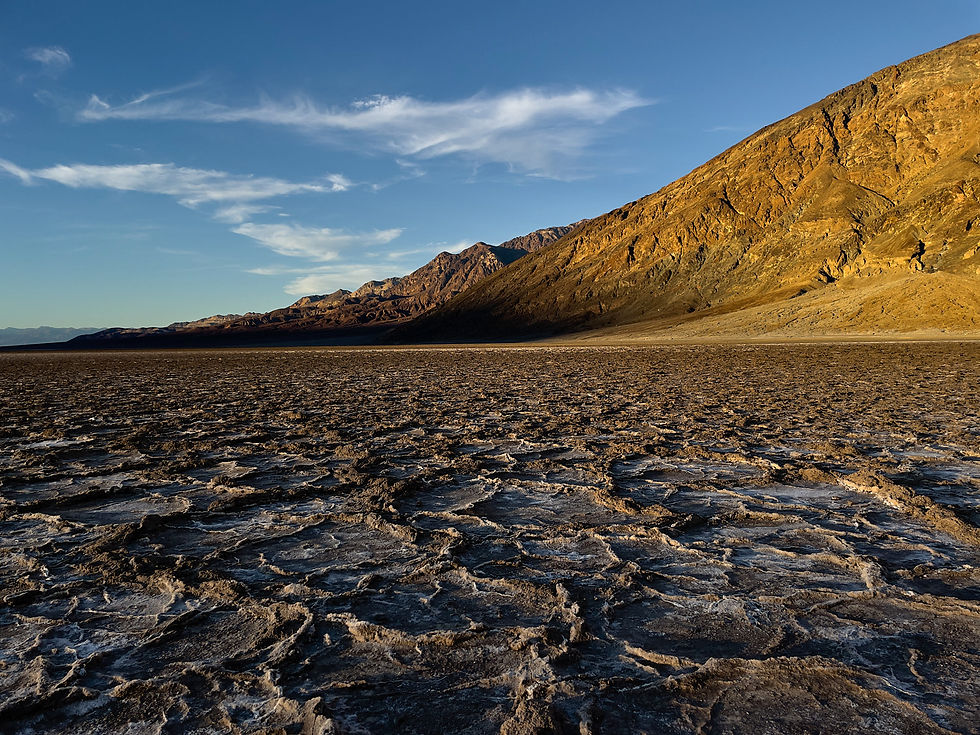
The Amargosa River, referred to as the "Crown Jewel of the Mojave Desert," is the only free-flowing river in this region of the Mojave Desert. Most of its 200 miles are underground. It is an ancient river and indigenous humans have lived along it for over 10,000 years. Nature and wildlife thrive from this life-giving watershed.
Desert Oasis
The largest remaining desert oasis of the Mojave Desert sits within Ash Meadows National Wildlife Refuge. Twenty-six (26) endemic species of plants and animals call the refuge's 24,000 acres home, including the endangered Amargosa pupfish and the critically endangered Devils Hole pupfish.

Ash Meadows NWR was internationally recognized during the 1971 Ramsar Convention as a Ramsar Site. It is one of the 41 USA wetland sites designated as Wetlands of International Importance. When you drive the area and walk along Ash Meadow's boardwalks you understand its importance to nature.
Ghost Town
It seems appropriate that remnants of eight (8) ghost towns are scattered across Death Valley. Rhyolite was the largest city with a peak population of 10,000 people during its heydays (1905-1911). Rusted, broken debris from the once thriving city are scattered across are the hillside where homes, stores, foundries, machine shops, an ice plant, hotels, school, an opera house, and houses of "ill repute" once stood. As the town boomed, it had 3 newspapers, an ice cream parlor, and the Stock Exchange and Board of Trade building. The 3-story building reportedly cost $90,000 to build with portions still standing.

Rhyolite, named after the silica-rich volcanic rock in the area, was founded in 1904. City founders, Shorty Harris and Ed Cross, discovered rhyolite crystal at their nearby Bullfrog mine.
Electricity came to the city in April 1907. The nearby Montgomery Shoshone mine boasted generating $10,000 per day from mined ore. Charles Schwab purchased the mine in 1906 for 2-6 million dollars.

However, the 1907 financial panic was the beginning of the end for Rhyolite. By 1910 only 611 residents lived in the town, newspapers stopped printing, and banks failed. The Montgomery Shoshone mine closed down on March 14, 1911. Then the railroad stopped running. The lights and power were turned off in 1916.
Alongside the remains of the town, lies an open-air, art museum—Goldwell. Belgian artist Albert Szukalski started the museum in 1984 with the creation and installation of his sculpture titled "The Last Supper."

Navajo Sandstone and Pink Skies
(November 4 - 7)
Coral Pink Sand Dunes State Park (UT)

Carried on Navajo sandstone, high winds blow nature's whispers through a notch between mountains where they build into salmon-pink dune fields at the Coral Pink Sand Dunes State Park.
Hikers, off-road vehicles, sand boarders, and horse riders claim the dunes as their daytime playground. While southwestern clouds painted pink fill the skies after the sun sets.

The state park is nestled behind the Moquith and Moccasin mountains in southwestern Utah between Mount Carmel Junction and Kanab (UT). This park is off the grid as none of the US cellular carriers provide coverage within the state park.

Castle in the Cliffs
(November 7 - 12)
Camp Verde (AZ)
"The 20-room high-rise apartment, nestled into a towering limestone cliff, tells a story of ingenuity, survival and ultimately, prosperity in an unforgiving desert landscape."

The nation's 3rd National Monument, Montezuma Castle, was dedicated in December 1906 by President Theodore Roosevelt "preserving our Native American culture." The Sinagua people built the dwelling approximately at the same time that Notre Dame Cathedral was constructed in Paris (1100-1300). The Sinagua left the area by the early 1400s for unknown reasons.
The Sinagua people were living in the area as early as 650 CE, as evident through uncovered remains of their earlier houses near Montezuma Well. These pit houses were built by inserting log posts into the ground, then covering with plant material. By 1050 CE, the Sinagua began building pueblos and cliff dwellings. The south facing cliff house offered warmth in the winter and coolness in the summer. They also provided protection from Beaver Creek floods while also offering views of approaching travelers.
Arcosanti
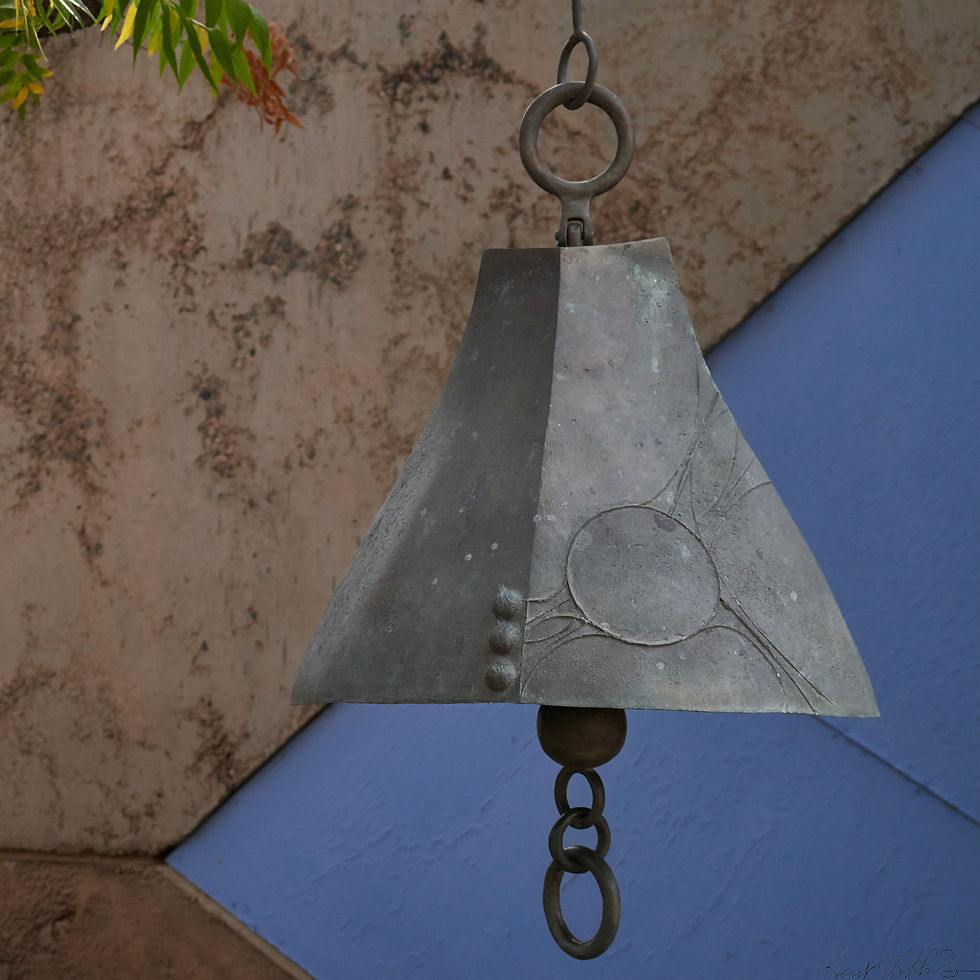
An hour south of Sedona off of Interstate I-17 sits the prototype arcology, Arcosanti. Arcology is "a field of creating architectural design principles for very densely populated and ecologically low-impact human habitats"—Wikipedia. This term was coined by Arcosanti designer and architect Paolo Soleria in 1969.
Soleri, through The Cosanti Foundation, constructed the city of Arcosanti in 1970 as a testing ground for his progressive urban planning concepts. The community continues today with an average of 70 full-time, year-round residents. Interns and volunteers live at Arcosanti for shorter periods of time while working on programs, projects, or initiatives.
Bronze windmills crafted in Arcosanti's working foundry are known throughout the world. Each bell is a unique piece of art created by on-site artisans using original Soleri bell patterns and a unique cast-in-place silt method. Earthen, hand-carved ceramic tiles are crafted in the on-site ceramic apse. Bronze and ceramic bells can be purchased at the gift shop or online. Revenue from the sale of bells, jewelry, tours, events, overnight stays, and donations keep Arcosanti operating.
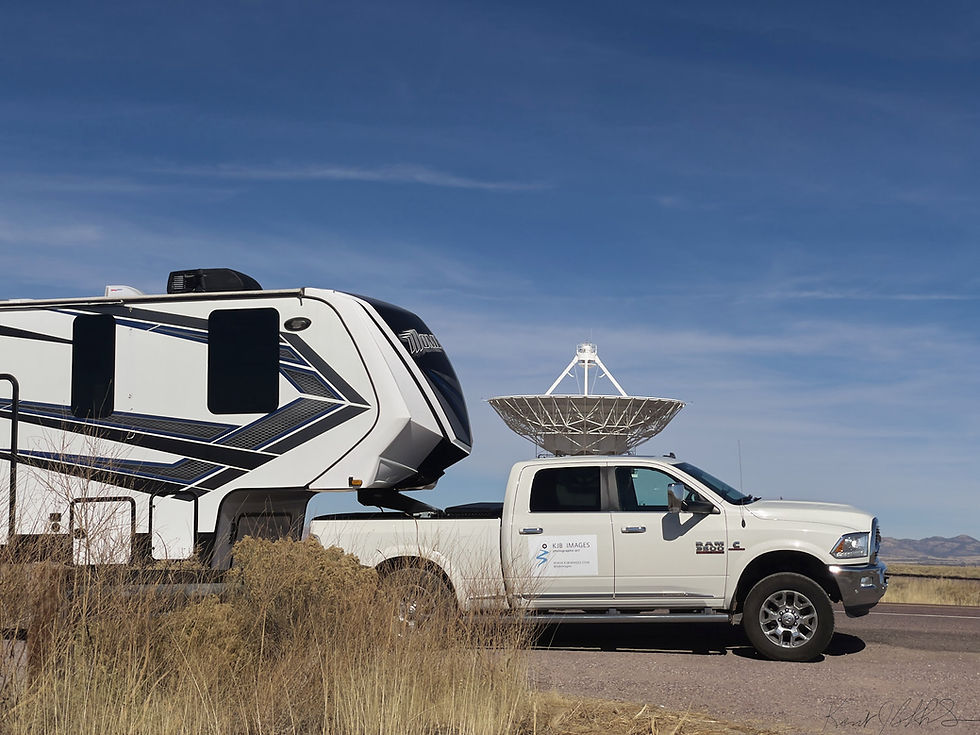
Hello
(November 12 - 18)
Lyman Lake State Park (AZ)

Heading east out of Camp Verde (AZ), I traversed the expansive forest of pine trees below the Mogollon Rim. This geological feature runs nearly 200 miles across the northern half of Arizona. Western novel author Zane Grey built a hunting cabin near Payson (AZ) that later was destroyed by a 1990 forest fire. The forests and hills found around the Mogollon Rim offer a scenic and environmental reprieve from Phoenix.

On the high desert of eastern Arizona near the New Mexico border is located Lyman Lake State Park. The park was created as part of an irrigation reservoir on the Little Colorado River. With fall in the air, boaters and campers were scarce so we had the park mostly to ourselves. The six days spent camping here, provided an opportunity to process images and catch up on other uncompleted tasks before heading into Alburquerque and Santa Fe for the Thanksgiving holiday.
Pies and Astronomy

Legend has it that in the 1920s, a Texan and WWI vet named Clyde Norman was passing along US 60 when his car broke down. Unable to fix his car, he opened a bakery on the spot he was stranded. He hung a sign with "Norman's Place" written on it and began selling dried-apple pies to travelers passing along US 60. The pies were a hit, and the area became known as "pie-town."
Pie Town (NM) holds an annual Pie Festival on the second Saturday of September. Pie Town boasts 3 restaurants: Pie-O-Neer Pies, Pie Town Pies, and Pie Town Cafe. I'm sure you know what has to be on their menus.

West of Pie Town along US 60 is a very large arrangement of radio telescopes laid out in a Y configuration, creatively known as VLA (Very Large Array). The National Radio Astronomy Observatory (NRAO) runs the VLA on the Plains of San Agustin east of Pie Town and northwest of Socorro (NM).
As you approach the VLA, you realize that each telescope is really large (82 ft dish) and the expansiveness of the array's configuration (up to 23 miles). The VLA was featured in the 1997 motion picture Contact starring Jodie Foster and Matthew McConaughey. The movie was based on the 1985 novel by Carl Sagan. Jodie Foster narrates a 24-minute film that runs at the VLA Visitor Center auditorium.
I decided that one of the dishes would mount nicely on Criss and provide us with some extraterrestrial radio entertainment as we crisscross the country. Feel free to comment below on your impression of our new antenna.

Gifts for Whispers & Criss
(November 18 - 28)
Albuquerque (NM)
Santa Fe (NM)

The week of Thanksgiving (November 21-28) put us in New Mexico. We rented a house in Santa Fe to spend the holiday with my adult children who flew in for the week. The house provided us an opportunity to have some maintenance work done on our rig and spread-out space for everyone. The kids worked remotely during the day, we played games during the evenings, and visited the area attractions on the weekends.
Some of our trips included visiting the Georgia O' Keefe Musuem, walking Canyon Road, strolling along The Railyard, driving up to Taos, and walking over the Rio Grande Gorge Bridge. The night before our trip to Taos it snowed so the mountains were dusted with snow!

Aloha Baby
You'll recall from a previous blog a July windstorm in South Dakota caused damage to our 18-foot awning. Since August, I had been working with RV parts and service centers to get a replacement awning. It was very challenging coordinating the lead times required for RV parts and service with our travel schedule. In September, I worked with Aloha RV in Alburquerque (NM) to order a new awning and hardware for Whispers the week of Thanksgiving—10 weeks ahead of time!
Thankfully, the parts arrived, we arrived, and we dropped off Whispers on November 22 to be fitted with her new awning. While picking up Whispers after the installation, the slider hitch on Criss broke. Double thanks, we were at an RV service center, and they had an exact replacement hitch in stock! This failure could have been a disaster for us if it had occurred while pulling Whispers. The great people of Aloha RV took out the old hitch and installed the new hitch while waiting.
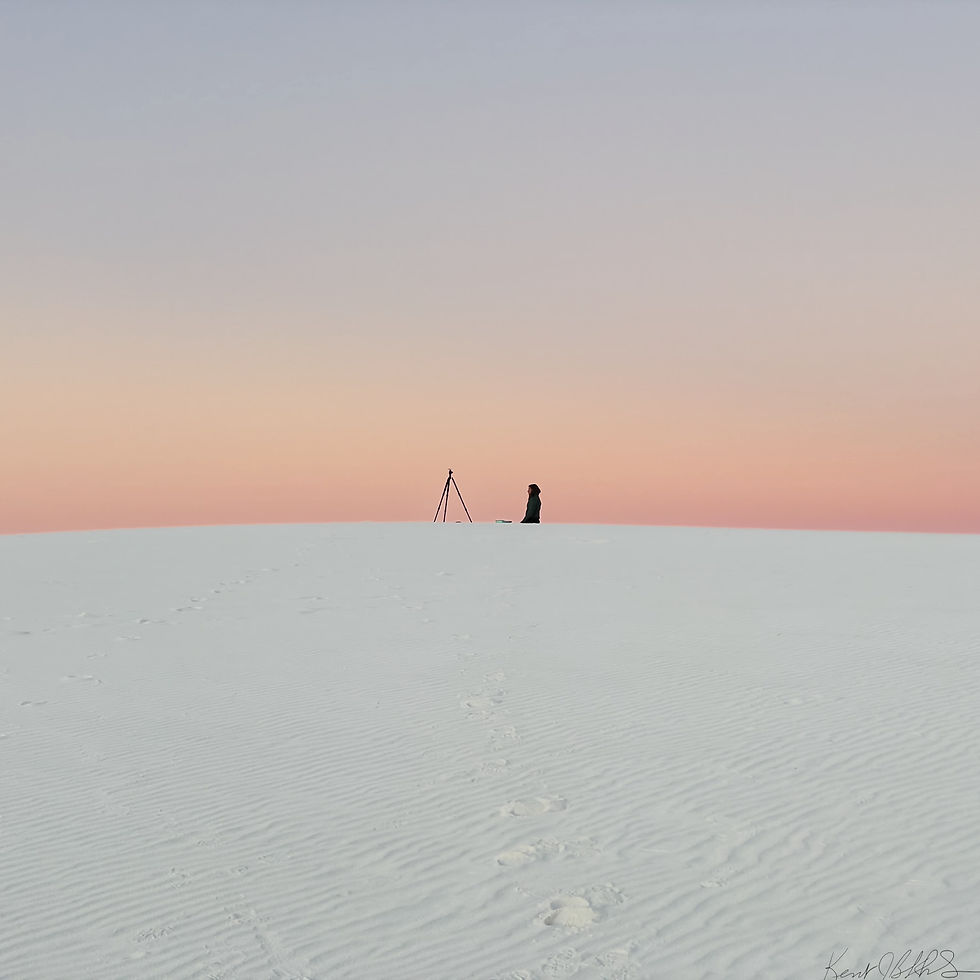
Nature's Zen
(November 28 - December 1)
Alamogordo (NM)
One of the world's great natural wonders exists outside of Alamogordo (NM)—White Sands National Park. The white dune fields are unlike any place I've experienced before—an out-of-mind experience.
My mind kept telling me I needed to drive cautiously, careful of sliding on turns. It told me to bundle up before stepping out of Criss. These dunes looked like giant snowbanks similar to the ones I experienced during my childhood in North Dakota.
It was 70F outside and the sand wasn't snow. It wasn't even sand! The dunes of White Sands NP are gypsum dunes. ypsum crystals form in the dry Chihuahuan Desert sun and break down into grains. The high winds blow the grains, forming dunes. There are only a handful of gypsum dune fields in the world. The three largest ones are located in the Chihuahuan Desert.
Peace and calmness transcend,
walking over white powder dunes.
Sounds evaporate.
Comparisons fade to nothingness.
Presence surrounds you,
nature imprints herself in your soul—
settling overhead
pink and blue palette whisper,
dune serenity
Feel free to share a story from your journeys in the comment section.
Or, add a comment about connecting with nature.

how much longer?
are we there yet?
how far to the next rest area?
“9 more miles”
9 more miles segment is a place where I share random road tidbits along the way during my capturing whispers from nature adventures.
In case you are wondering "are we there yet?"
“just 9 more miles"













The dune picks are amazing.
Seems like my blog is attractive to Bills. :-)
The images are as stunning as the trip is fabulous! I question the logic of equipping Criss with an 82' dish. Coefficient of drag will become ....... well, a drag.
Magnificent shots!